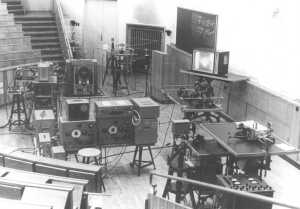City Communication Space
Photography of a laser demonstration
Image: Physikalisch-Astronomische-Fakultät JenaA Guide to the History of Physics for Jena
With respect to the history of physics, Jena has an extra-ordinarily rich past, even though it is one of the smaller cities in Germany. Ernst Abbe’s collaboration with Carl Zeiss, the Abbe theory of the microscope and the construction of microscopes on a scientific basis are closely linked in the collective memory with the city of Saale. Likewise, the design and construction of the first large projection planetarium in Jena is widely known. However, it is not common knowledge that already a 250 years ago Erhard Weigel built a planetarium in the form of a walk-in globe of the heavens [eines begehbaren Himmelsglobus] with a five and a half metre diameter. Johanne Wilhelm Ritter’s discovery of ultra-violet light, Hans Berger’s recording of the first electroencephalogram and Hans Busch’s description and calculation of electro-magnetic lenses, which were fundamental to the subsequent development of electron microscopes: all these are examples of the wide-ranging significance of Saale in the history of physics.
Since 2012, the European Physical Society has designated as Historical Sites such places where important discoveries were made for the history of physics. Although usually individual buildings or building complexes receive this honour, Christian Forstner (Chair of the Specialist Association the History of Physics of the German Physical Society [Fachverbandes Geschichte der Physik der Deutschen Physikalischen Gesellschaft]) nominated the “city of Jena” itself because of the unusual density of significant sites in the history of physics there. The project of creating a city guide was also launched within the framework of this application.
The different aspects of the history of physics at Jena, the astronomical tradition that has lasted for five hundred years, extending through the history of optics up to solid state physics, was given a temporal and spatial location and structure in the associated buildings. Scientific political endeavours (such as the calendar reform advanced by Erhard Weigel in states [Länder] with Protestant governments), the popularization of science (like Hermann Schaeffer’s “physics of the poor [Physik der Armen]”), the close connection between precision measurement techniques and fundamental research (Georg Joos’ Michelson-Morley experiment is paradigmatic here) as well as the connections between art, architecture and physics (as presented in Felix Auerbach’s home) are to be vividly portrayed, always keeping in view the underlying social, technical and political conditions.
The findings were printed in the form of a city guide in the series “Jenaer Beiträge zur Physikgeschichte[Jena Contributions to the History of Physics]” published by the GNT-Verlag. Furthermore, the buildings were marked with signs and QR codes. The web documentation accessible via it includes a map with a route that can be followed using a Smartphone or tablet in addition to a short architectural-historical description of the individual buildings and its significance in the history of physics.
